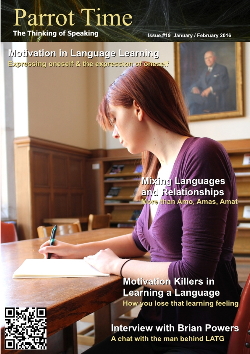Motivation
Expressing oneself and the expression of oneself in language learning
|
Section III: A vivid Imagination Imagination comes up frequently in motivational research. Students who imagine themselves speaking their target language are more likely to succeed in their endeavour. I am not talking here about imagining yourself in a parallel world, but rather projecting yourself in that existing community of speakers to which you don't yet belong. How does it look and feel? Do you imagine yourself making light chit chat at the till in small town Saudi Arabia, presenting to a group of potential investors in Kenya, or striking a conversation with a complete stranger on your 3.14 train to Vladivostok? Whatever rocks your boat, keep those images preciously and replay them in your head. When you are eventually in those situations, what feeling of accomplishment! If you teach language, and even if you don't, you may well have heard of the almost mechanical ZPD, the zone of proximal development. When I was a teenager I read Stephen King a lot, and subsequently ZPD always reminded me of Dead Zone – great book and loved the movie (who doesn't love Christopher Walken??). Anyway, that's for a different column. ZPD is the identification of the gap between the level a student is at and the reasonably challenging goal they need to reach. For decades teachers like me, in their sense of self-importance, thought that they were the judge of the gap to bridge. However, if you allow your students to become more active in their learning, they will also identify a gap. The teacher doesn't need to pretend to know everything about their students' cognitive system, and the student is potentially much happier to have been able to set their own goals. In fact, one of the major theoretical contribution to the sociocultural tradition from which ZPD originated is Self-Determination Theory. That's right, the theory that tells us how unbelievable effective it is to let students become their own learning agent. So how will the student identify the gap to their learning goals? It's a little like the 17th century Descartes's argument in that God exists: how can I know what perfection is if I am not perfect? It must have been infused in me by some perfect being. Thus God must exist. Despite my own lack of belief, I can see the nice, nice and nice logic in the argument. But Descartes was all logic and no imagination! The student can see with incredible clarity what they don't yet know. Conclusion  Motivation remains as slippery a concept as ever. Like so many other socio-cognitive processes, we know what motivation is, but we would be hard press to define it. However, it seems that we are now in a better position to accept its slipperiness. In fact, it serves us well not to define it too sharply, because a little bit of vagueness means that we can be more flexible when thinking about it. Many factors play in your success to learn a foreign language. Motivation is just one of them. Another factor is your learning ability. But when you talk to people about their success or otherwise in learning languages, they often highlight one factor above all else. That's because it often feels that way. But take a minute and reflect about everything that has helped or hindered your learning pathway. Over the past couple of decades, a realisation dawned over those who research acquisition of second language. The learning process is not cumulative, it's developmental. You don't get to know a new language because you learnt it formally. You know it because you learned, experienced, made mistakes, plateaued, regressed, improved, got sick of it, talked to others, cried, screamed, loved. It's in the midst of those changes that you find motivation. Olivier Elzingre is a PhD candidate researching motivation and identity development in study abroad contexts. He teaches high school French in Australia. Correspondence to olivierrelzingre@gmail.com Parrot Time is always looking for guest writers, so if you are interested in writing for us or donating something you have written for your own blog, please contact us at editor@parrottime.com. We look forward to your contributions! |
| Motivation: Expressing oneself and the expression of oneself in language learning | ||||||
| Writer: | Olivier Elzingre | |||||
| Images: | ||||||
| ||||||
| Sources: | ||||||
| ||||||
All images are Copyright - CC BY-SA (Creative Commons Share Alike) by their respective owners, except for Petey, which is Public Domain (PD) or unless otherwise noted.
comments powered by Disqus
















